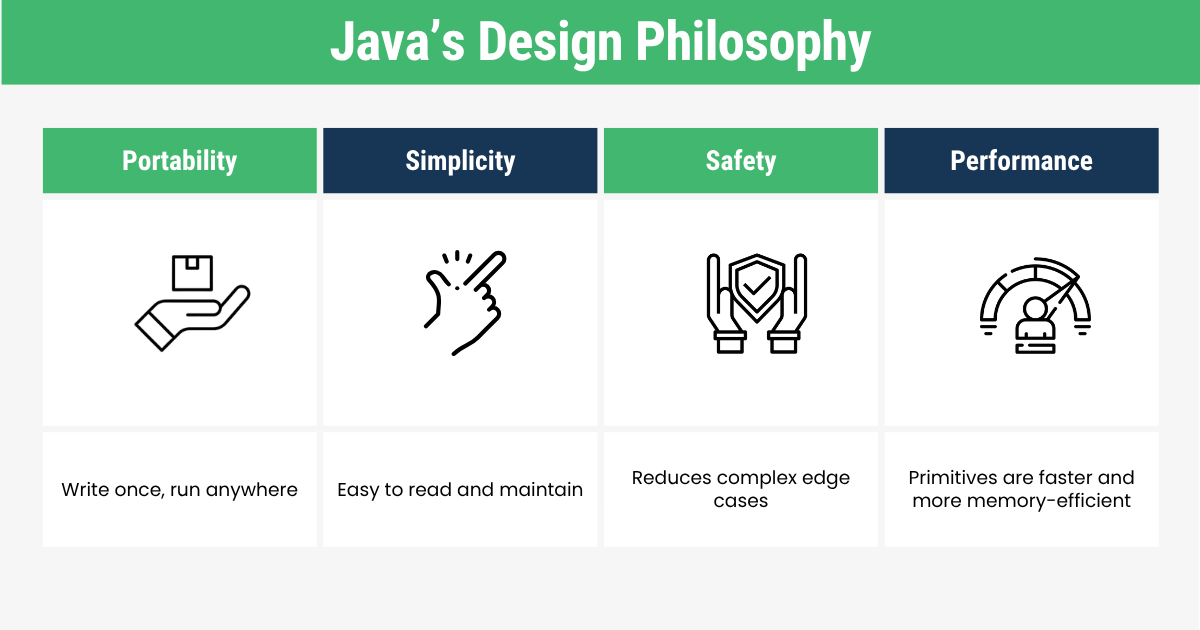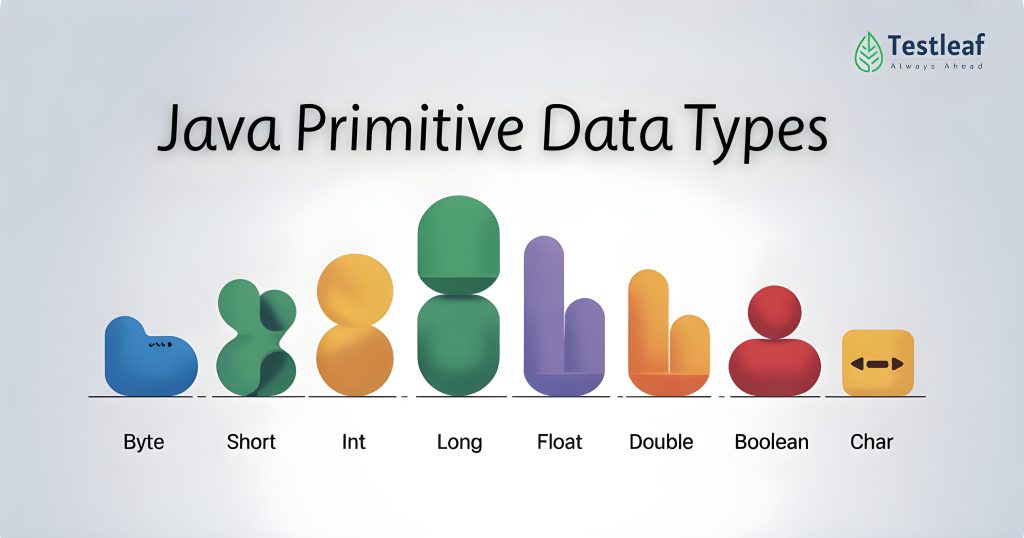Introduction
In the world of programming, understanding data types is foundational—and in Java, this foundation is both solid and consistent. Java was designed with the principle of “write once, run anywhere,” and its approach to data types reflects this goal. Unlike languages where data type behavior can vary by platform, Java enforces strict rules around how data is stored and manipulated. This document provides a clear and comprehensive overview of Java’s primitive data types, their fixed sizes, and the reasoning behind certain design choices—like why Java avoids unsigned integers. Whether you’re a beginner or refreshing your knowledge, this guide will help you understand how Java handles data efficiently, safely, and portably.
Java Primitive Types Explained!
Java has 8 primitive data types, each tailored to hold simple values efficiently. These types are not objects but offer raw, high-performance capabilities for speed-critical operations.
| Type | Size | Description |
| byte | 8-bit | Smallest integer, range: -128 to 127 |
| short | 16-bit | Larger than byte, less common |
| int | 32-bit | Most commonly used integer |
| long | 64-bit | For very large integers |
| float | 32-bit | Decimals with less precision |
| double | 64-bit | High-precision decimal values |
| char | 16-bit | Single Unicode character |
| boolean | 1-bit | Holds either true or false |
Even though Java is fully object-oriented, these primitives are exceptions to enhance performance and memory efficiency. Think of them as the ‘speed boosters’ of Java!
Popular Articles: automation testing interview questions
Fixed Size = Predictable Behavior
One of Java’s strengths lies in its consistency across platforms. In languages like C or C++, the size of an int may vary depending on the system architecture. However, Java standardizes data type sizes:
For example, an int is always 32 bits—whether you’re running Java on Windows, Linux, or macOS.
This strict sizing ensures that Java programs behave the same on all platforms, promoting true portability. Your code works anywhere, with no surprises.
Other Helpful Articles: Top 8 best IDE for selenium with Java
Why No Unsigned Integers in Java?
Unlike languages such as C++, Java doesn’t support unsigned integers (which hold only positive numbers). Here’s why Java avoids them:
- Simplicity: Java’s goal is to be simple and readable. Adding unsigned types would increase complexity, requiring more casting and additional rules.
- Safety: Mixing signed and unsigned types can introduce subtle bugs and unexpected behaviors. By avoiding them, Java eliminates a whole class of potential errors.
- Rare Need: Most applications don’t need unsigned types. When they do, developers can use larger signed types as a workaround.
Example: Need an unsigned 32-bit integer (0 to 4 billion)? Just use a signed long, which can go up to over 9 quintillion.
Summary: Java’s Design Philosophy
Java was built on the principles of consistency, reliability, and simplicity. These design choices make Java code:
- Easy to understand and maintain
- Portable across different systems
- Safe and secure by minimizing complex edge cases
- Efficient in terms of memory and performance

Java = Write Once, Run Everywhere
By enforcing fixed data type sizes and avoiding complex features like unsigned integers, Java prioritizes code clarity, platform independence, and safety. While there might be a tiny trade-off in performance or flexibility, the result is a highly stable and developer-friendly language.
Conclusion
Java’s data type system is a prime example of its thoughtful and pragmatic design. By sticking to fixed sizes, excluding unsigned types, and optimizing performance through primitive types, Java ensures reliability and simplicity for developers across the globe. These choices make Java not only easy to learn but also powerful enough for enterprise-grade applications. Understanding these fundamentals equips you to write clearer, safer, and more portable code—living up to Java’s promise: Write once, run everywhere.
If you’re learning Java for Selenium or planning to build automation test scripts, don’t miss our step-by-step guide to mastering Selenium with Java. It will boost your skills and help you build robust automation frameworks.
FAQ
Q1: What are the primitive data types in Java?
Java has 8 primitive types: byte, short, int, long, float, double, char, and boolean.
Q2: Why doesn’t Java support unsigned int?
To simplify the language and avoid common bugs found in signed/unsigned arithmetic.
Q3: What’s the difference between int and Integer in Java?int is a primitive type, while Integer is a wrapper class (an object).
Q4: Why are primitive types used in Java?
They provide fast, memory-efficient operations for performance-critical tasks.
We Also Provide Training In:
- Advanced Selenium Training
- Playwright Training
- Gen AI Training
- AWS Training
- REST API Training
- Full Stack Training
- Appium Training
- DevOps Training
- JMeter Performance Training
Author’s Bio:

As a Senior SDET, I’m passionate about advancing the field of test automation by equipping teams with real-time solutions and high-impact frameworks. With over 8 years of experience in software testing and development, I specialize in building scalable automation platforms that ensure quality at speed. I’m committed to mentoring aspiring engineers and driving innovation through continuous learning and technical excellence. Let’s shape the future of quality engineering—together.
Dilipkumar Rajendran
Senior SDET | Playwright & Selenium Expert






